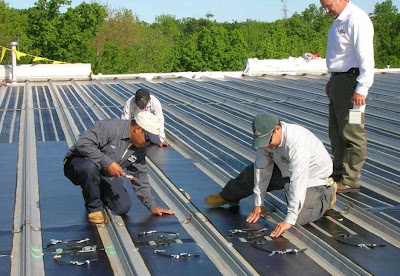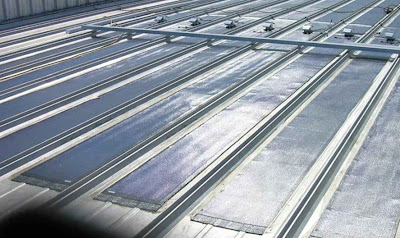
Real-World PV Installation
From an article written by Michelle Bennett
Published on May 24th, 2008 at: http://cleantechnica.com/2008/05/24/a-thin-film-solar-panel-installation/
I recently read a 'real' article about the installation of a thinfilm PV roof system being installed. The writer of the piece, Michelle Bennett, has kindly given me permission to quote her article. I found the piece interesting because it comes straight out from “the real world” and not from some overpaid spin doctors writing a load of business-speak aka “bull shine” for some speculative investment company or other.
Michelle writes:
Many people envision solar power as rigid silicon panels mounted on a roof. With thin film solar cells, you’re more likely to not see them, or even know they’re there. This article is about a real-life thin film solar project.
Not many bloggers are able to witness the technologies we research and write about. It’s one thing to be able to buy afford a cool “green” gadget (usually not very green), but another to see the many forms of solar, wind, geothermal, etc., which are always changing and developing around the world. So when my employer decided to go solar, you might imagine my excitement.
At the moment I work for Magco Inc., a Tecta America company. Tecta is a national commercial roofing corporation that can install green roofs, solar lighting, and solar panels alongside a variety of traditional roofing systems. This solar project is pretty straightforward: our building has a big, flat roof on top of a hill without any shade. You’d have trouble finding a sunnier spot for solar panels.
I was double delighted when I heard that they ordered thin-film solar! Naturally inquiring minds wanted to know: why and what kind?
Magco bought their solar from Uni-Solar, which produces triple-junction laminate panels. That means they laminate the photovoltaic chemicals onto a thin sheet of metal in three layers; each layer reacts to a different range of light. They also laminate a sealant on the panel to protect it from the elements. The benefit of this system is that it reacts better to low or indirect light. Think cloudy days and the hours around dusk and dawn, a. Uni-Solar’s panels operate around 12% efficiency, but they claim to out-perform other forms of PV solar in indirect light, which means they could produce more electricity in certain real-world conditions (cloudy days). The laminate production method also decreases cost because expensive silicon and mounting racks are not required.

These thin-film solar panels are glued straight onto the roof. (See picture.)
Magco chose these panels for another important reason: no roof penetrations. If you mount racks on your roof, you have to fasten them down. That means punching holes in the roof, which can void your warranty and even damage your roof if it’s not done right. Some solar systems, even silicon panels, have found ways to avoid these problems, and anyone looking into solar should ask about the integrity of their existing roof. Another bonus for Magco and thin-film solar was weight: these solar panels roll out like carpet and don’t weigh as much as silicon. That means Magco wouldn’t need to add any structural support. It does snow here, so weight is an important factor!
What about the electrical aspect? Special runners help connect and protect wires between panels and represent the only mounted equipment in the system. The wires eventually find their way to a big inverter inside the building, which feeds the electricity to us. A 2-way power meter can then feed any excess electricity back into the grid. Simple, right? Well, for a project this big and complicated you’d definitely want to hire some professionals. If you mix up which-wires-go-where, you could make some very expensive mistakes or just rob yourself of some of your solar power.
What if you and your neighbours want to go solar but can’t afford it? Bulk your order and get it done at the same time. Combining your orders will reduce costs in man-hours and equipment (think crane rentals). Naturally you can also get a better deal on the panels themselves if you buy in larger quantity.
Images Courtesy of Patrick Bollinger. Thank you Patrick!
In answer to my comment and request to copy material MichelleBennett said on May 28th, 2008 at 9:48 am @ Tony:
I wish I could give you (and all our other readers) some real numbers for this panel on any given day, but at the moment they’re still finishing the last of the electrical work. Who knew there were so many wires?
I’m not sure if Magco intends to monitor the real-world output of their solar panels (wouldn’t surprise me if they did). Unfortunately this is my last week working with the company, so I won’t be around to monitor the system myself. I do, however, have all the contact information I need to write a follow-up post in the future. Stay tuned.
Tony, you can feel free to quote away! I’m glad you like my article *that* much. Some link love would also be appreciated, of course. If you have any other questions, just let me know.
Michelle’s original piece can be seen at: http://cleantechnica.com/2008/05/24/a-thin-film-solar-panel-installation/
Michelle's articles are listed at: http://greenoptions.com/author/michellebennett
Good luck to Michelle with her future career, and I look forward to updates on the Magco PV roof installation.
.


No comments:
Post a Comment